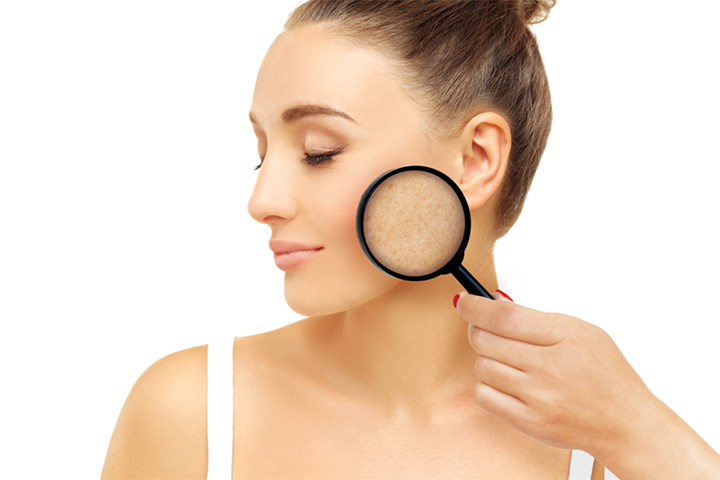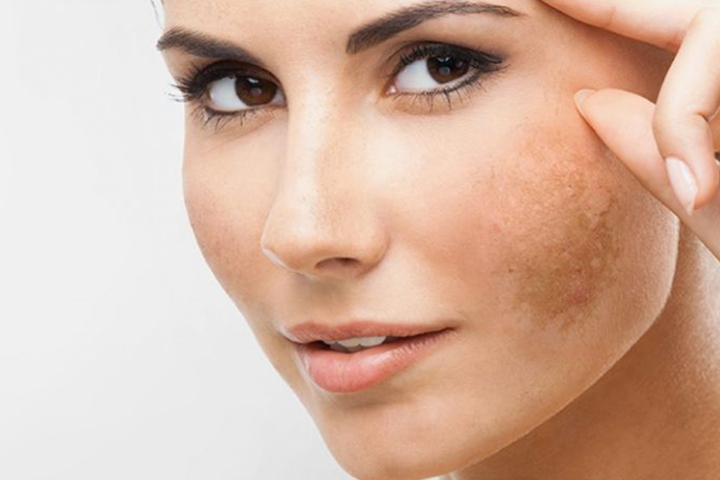What is Pigmentation?
Age spots, freckles, lentigines, melasma, and birthmarks are commonly referred to as a pigmented lesion. Birthmarks are present at birth. Other pigmentation issues like freckles and melasma develop as we age and due to overexposure to the sun over the years. With the consistent and appropriate course of treatment, pigmentation can be lightened or removed with minimal downtime or discomfort.
How Blue Light Affects Skin Pigmentation
While the sun’s UV rays are the primary cause of pigmentation issues, visible light, particularly blue light from devices like smartphones, computers, and tablets, also contributes to pigmentation and skin aging. Blue light has a longer wavelength than UV radiation, allowing it to penetrate deeper into the skin.
This exposure triggers the activation of a receptor called Opsin, leading to the production of pigments like melanin. Over time, this can result in pigmentation such as dark spots and an uneven skin tone. Given the sunny climate and high digital device usage in Singapore, blue light exposure is an important factor to consider when addressing pigmentation concerns.
Protecting Your Skin from Blue Light and UV Rays
To minimise pigmentation caused by blue light and UV radiation:
Apply Broad-Spectrum Sunscreen: Use a sunscreen with an SPF of 50 or higher daily, even when indoors, as sunlight and blue light can penetrate windows.
Choose Tinted Sunscreens: Opt for sunscreens containing iron oxide, which provide additional protection against blue light. These are particularly effective for individuals who spend long hours in front of screens.
Reapply Sunscreen Regularly: Reapply every 2–3 hours if you’re outdoors or exposed to prolonged sunlight.
Use Screen Filters: Consider using blue light filters or screen protectors on your devices to further reduce exposure.
Additional Treatment Options for Pigmentation
Beyond laser treatments, there are other effective non-invasive options to address pigmentation concerns:
Topical Treatments:
Hydroquinone Cream: This prescription-strength cream can be applied to affected areas to lighten pigmentation. It’s often used for 2–4 months and requires a doctor’s guidance for safe and effective use.
Chemical Peels:
Chemical peels, particularly those containing glycolic acid or alpha-hydroxy acids (AHAs), help exfoliate the skin’s outer layer and fade pigmentation.
These treatments are typically done at intervals of 3–4 weeks and are suitable for pigmentation that doesn’t respond well to topical therapies alone.
Comprehensive Pigmentation Treatment Solutions
Pigmentation issues often require a combination of prevention and treatment. By incorporating broad-spectrum sun protection, skincare tailored to your needs, and advanced medical treatments like lasers or chemical peels, you can achieve a more even and radiant skin tone.
For more personalized advice, consult with a specialist who can recommend the most suitable treatments for your unique skin concerns.
What are the types of pigmentation disorders and their symptoms?

Liver Spots/ Age Spots
Age spots are flat brown, gray, or black spots on the skin. They vary in size and usually appear on areas exposed to the sun, e.g. the face, neck, shoulders, and arms. Age spots are also called sunspots, liver spots and solar lentigines. They are often associated with sun exposure and can appear suddenly as you age. Many patients in Singapore seek sun spots removal treatments to lighten these areas.
Melasma
Melasma is a common pigmentation disorder affecting Asian skin. Sometimes referred to as the mask of pregnancy, it may be triggered by an increase in hormones in pregnant women. Melasma causes patches of discolouration, usually brown or gray patches, to appear on the skin, primarily on the face. The most common areas include the bridge of the nose, forehead, and cheeks. Those seeking melasma treatment in Singapore can benefit from a tailored approach that considers skin type and pigmentation depth.
Freckles
Freckles are flat, light brown circular spots that typically appear on sun-exposed skin and are often a result of genetics. Freckles are more common on the face of individuals with lighter pigmentation and fair skin tone. Youngs children may develop freckles as early as 2 years old. Freckles are produced by exposure to ultraviolet light and may fade with reduced sun exposure. Some individuals consider laser treatment for freckles to achieve a more even skin tone.
Acne Marks (Post-inflammatory hyperpigmentation marks)
The red or brown marks that remain after blemishes have healed are caused by pigmentation and are known as post-inflammatory hyperpigmentation marks(PIH). PIH or acne marks are stubborn and hard to get rid of without proper treatment.What causes skin pigmentation?
Sun Exposure
The sun’s UV rays stimulate the production of melanin, the pigment responsible for skin color. Over time, this can lead to uneven pigmentation, dark spots, and an overall dull complexion. Sun exposure is one of the most common causes of pigmentation and can worsen existing pigmentation.
Hormonal Changes
Hormonal fluctuations, especially during pregnancy or due to contraceptive use, can trigger an increase in melanin production. This often results in hormonal pigmentation, including melasma, which presents as dark patches on the skin.
Genetics
A family history of freckles, age spots, or certain skin pigmentation disorders can increase your likelihood of developing similar issues.
Inflammatory Conditions
When the skin experiences trauma or inflammation, an excess of melanin may be produced, leaving behind dark marks or discolouration.
Pollution and Environmental Stressors
Exposure to pollutants and free radicals can accelerate the ageing process and contribute to pigmentation issues over time.
What Is Pigmentation Laser Treatment and How Does It Work?
Understanding how pigmentation laser works can help you decide if it’s right for you. During pigmentation laser treatment in Singapore, concentrated light energy targets pigmented areas, breaking down melanin into smaller particles that the body naturally clears. This process helps to lighten pigmentation and support a more even skin tone over time.
Pigmentation Laser Treatment is Suitable for
- Most skin type
Limitation of Pigmentation Laser Treatment
- Hypopigmentation (skin pigmentation disorder)
- Photo allergy (sensitive to light treatment)
- Pregnancy
Preparation for the Treatment
- Inform your physician if you are on oral medication
- Avoid sun exposure 1 week before Laser / BBL treatment
- Stop lightening products
What to Expect During Pigmentation Laser Treatment
- Numbing cream to minimize any discomfort
- Warm tingling sensation
- Treatment duration within 45min
- Redness or swelling (if any) should subside within treatment day or the day after
Post Care of Pigmentation Laser Treatment
- Avoid sun exposure or direct heat contact
- Avoid abrasive skincare products (scrubs, exfoliation)
- Scabbing might happen but avoid picking on dry skin
- Be generous with sun protection products
Pigmentation Laser Treatment Intervals
- Repeat treatment every 2 to 4 weeks, or if necessary
Pigmentation Laser Treatments Solution:
Pico Laser for Deep Pigmentation
Pico Laser treatments use ultra-short laser pulses to target and fragment deeper pigmentation without damaging surrounding skin. This approach can be suitable for stubborn pigmentation such as deeper melasma or long-standing sunspots.
Forever Young BBL
A study from Stanford University shows that Forever Young BBL can reverse signs of aging and delay the aging process.
Pro Yellow Laser
It has been popular for its ability to target both pigmentation and underlying vessels for long-lasting results.
Revlite Laser
This laser is effective in removing Hori’s naevus, naevus of Ota, sun damage spots like melasma, age spots, freckles or birthmark.
4D Pro Laser
The FRAC3® mode in Fotona Laser can help repair skin imperfections such as sun spots, lesions, uneven skin tone and texture.
Looking for freckles removal in Singapore and melasma treatment in Singapore? Consult our doctor now and we will advise suitable treatment based on your condition.
Is Pigmentation Laser Treatment Suitable for You?
You may be asking “Is pigmentation laser suitable for Asian skin?” The answer to depends on several factors. Your skin type, pigmentation pattern, and medical history all influence the treatment plan. Some lasers may be adjusted for specific skin tones to reduce the risk of side effects. A doctor’s consultation is essential before starting any laser programme to ensure the approach is both safe and appropriate for your individual needs.
Why Choose Healthsprings for Pigmentation Removal?
Licensed Doctors with Over 25 Years of Experience
All pigmentation treatments are performed by trained medical professionals with more than two decades of clinical practice.
Personalised Skin Analysis and Treatment Planning
We begin each treatment journey with a skin assessment to determine the most suitable approach. Plans are customised to address your specific pigmentation type and overall skin health.
MOH-Licensed Aesthetic Clinic in Singapore
Our clinic is licensed by the Ministry of Health to provide aesthetic medical services, ensuring that treatments meet required safety and quality standards.
Book your Laser Trial Session with us from $380!
Treatment options available
- Forever Young BBL
- 4D Pro Laser
- Cream
- Q-Switched Laser
- Pro Yellow Laser
- Chemical Peel
FAQs about Pigmentation Laser Treatment
How does the laser work to treat pigmentation?
Pigmentation laser treatment in Singapore works by emitting light energy that is absorbed by the pigmentation in the skin. This breaks down the pigment into smaller particles, which are then naturally removed by the body over time. For more information on the different types of pigmentation treated, visit our blog.
Is pigmentation laser treatment safe?
Yes, when performed by a qualified practitioner, pigmentation laser treatment is safe with minimal risks. At Healthsprings, our team of experienced professionals ensures all procedures adhere to high safety standards. Learn more about our clinic’s expertise here.
What types of pigmentation can be treated with lasers?
Pigmentation laser treatment can address various issues, including sunspots, freckles, age spots, and melasma. Each treatment is tailored to effectively target specific concerns, ensuring optimal results. To find out more about our services, explore our full range of treatments.
Is there any downtime after pigmentation laser treatment?
There is typically minimal downtime, with only mild redness or swelling immediately after the procedure. Most patients resume their normal routine shortly. For more details on post-treatment care, check our blog for expert tips on skin recovery.
Can pigmentation laser treatment be used on all skin types?
Thanks to advancements in laser technology, pigmentation treatment in Singapore is now available for various skin types. However, a thorough consultation is essential to ensure the right approach for your skin. Schedule an online consultation with our professionals to assess your skin’s needs.


